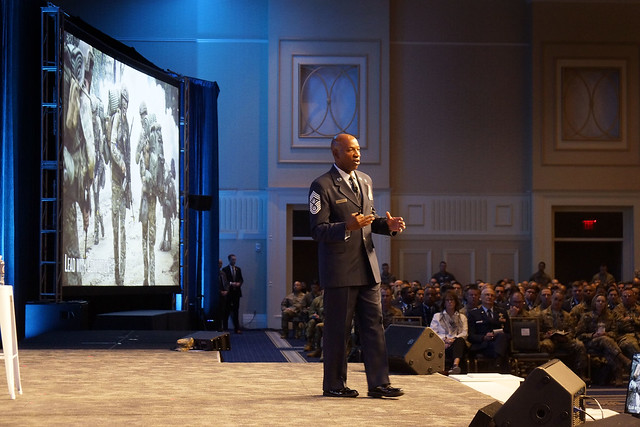
Chief Master Sergeant of the Air Force Kaleth Wright speaks at AFA's Air, Space & Cyber Conference in National Harbor, Md., Sept. 18, 2019. Staff photo by Mike Tsukamoto.
The Air Force is considering spacing out the time between when an airmen’s abdominal circumference is measured and when they complete the other components of the Air Force physical fitness test to lessen the likelihood of them going to potentially lethal lengths to pass, Chief Master Sergeant of the Air Force Kaleth Wright said Sept. 18.
“They take certain things, they starve themselves, they go out of their way to make sure that they get a good [score] ‘cause it counts for 20 percent of the test,” Wright explained during a Sept. 18 keynote address at AFA’s 2019 Air, Space & Cyber Conference in National Harbor, Md., outside of Washington, D.C. “And then they try to run or do the other components, and we’ve had airmen that have lost their lives.”
This quest for smaller measurements has caused injuries and illness in other airmen, he said.
In response, the Air Force started to consider “separating the time from when you tape and when you actually take the other component,” though “this stuff is all in the preliminary phases,” Wright said.
Wright said the Air Force has also thought about putting mock fitness tests in place that could serve as practice runs for airmen who are current on their PT tests. While a failure on one of these prospective tests would be “no harm, no foul,” a pass would cover their PT requirement for the next year. He also recently floated an idea that would allow airmen who fail their actual PT tests to retake them within a certain grace period, with no negative ramifications for the airmen if they passed within the given time.
Additionally, Wright said he aspires for the service to use swimming or cycling instead of running to measure airmen’s maximal oxygen uptake, which he said can serve as an indicator of a service member’s overall fitness. However, he said, the Air Force hasn’t “gotten there yet.”
His remarks are in line with his vision for Air Force health to become more holistic.